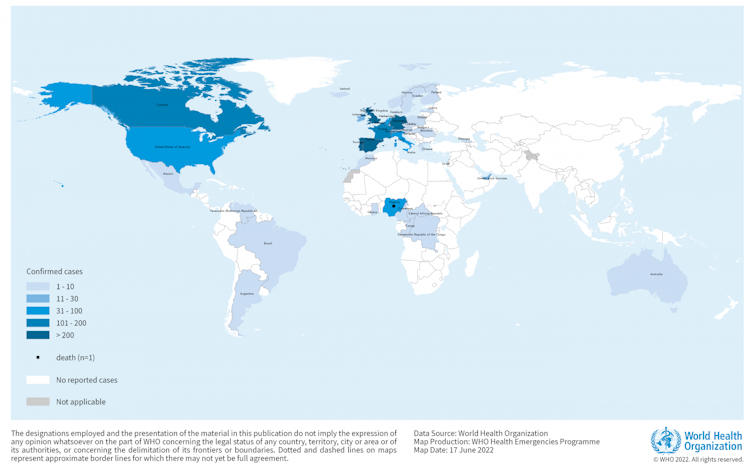Monkeypox: inform indiscriminately to protect
- June 24, 2022
- 0
GETTY IMAGES is one of approximately 20 patients infected with monkeypox in the United States in 2003, when the first cases were reported in the United States. According
GETTY IMAGES is one of approximately 20 patients infected with monkeypox in the United States in 2003, when the first cases were reported in the United States. According


According to WHO data, between January and June 15, 2022, there were 2,103 human cases of monkeypox (and one death in Nigeria) in 42 countries.
Spain became the second country with the highest number of cases after the UK. According to the Ministry of Health data updated on 16 June, 497 cases, more than 70%, have been reported in the Community of Madrid. 99% are men with an average age of 36. Eleven had to be hospitalized and there were no deaths. Where information is available, the most likely mechanism of transmission is intimate male-to-male sexual contact.

The knowledge we currently have about the characteristics of the virus and the disease makes us optimistic about the future development of this epidemic.
Monkeypox, unlike covid-19, is not a virus. newit is relatively stable, and the immunity gained after the disease is long-lasting, is not very effectively transmitted between humans, and the disease it produces is mild in most cases.
In addition, a large proportion of the adult population has prior immunity from the smallpox vaccine, can be detected quickly, and there are third-generation vaccines and new specific treatments for the most serious cases.
However, it is worrying that the disease continues to spread in countries where it was not endemic before. There are more and more cases and in more and more countries, and it cannot be ruled out that the virus has spread to other population groups.
There is also concern that the virus could be transmitted. jump from humans to animals and, for example, via domestic animals to other wild animals, where it can establish itself and become endemic in non-African countries (this virus can infect more than 40 different animal species, especially rodents). The fact that monkeypox has become established outside of the African continent is not good news.
So far, as in Spain, the vast majority of cases have occurred in men who have had sex with other men. This does not mean that homosexuals have the disease; Anyone can be infected. However, the risk for the general population is low. However, men who attend parties or places where they have sex with other men, with few partners, and in many cases without even knowing the other person’s identity, are at higher risk of contracting an infection. There is no doubt that a balance has to be struck between informing any group and not discriminating, but in this case clear information must be provided to protect these most vulnerable people.
As one of the countries with the highest number of cases in Spain, it is surprising that there is no information from the health authorities, especially in the summer months when celebrations and mass events increase. It is very important to explain how the disease spreads, what symptoms it has and, above all, how it can be prevented. Inform without discrimination to protect groups most at risk.
Monkeypox can infect anyone:
All of these can occur during oral, anal, and vaginal sex, or during intimate sexual contact, which includes touching the genitals or anus, hugging, massaging, or kissing and close conversation, touching fabrics and objects that have been used by an infected person during intercourse, bedding, towels, and like sex toys.
Early symptoms are similar to many viral infections and may include:
A characteristic is inflammation of the lymph nodes, mainly in the neck, armpits and English.
Normally, three days after the first symptoms appear, a typical skin rash starts from the site of primary infection and quickly spreads to other parts of the body. Sometimes they occur near the genitals or anus, as well as in other areas such as the hands and feet. They can also appear on the chest or face.
Wounds go through several stages before they crust over and heal. They can even be inside the body, in the mouth, vagina, or anus. The virus can spread from the time symptoms begin until all sores have healed and a new layer of skin has formed. This may take several weeks.
To contain these outbreaks and prevent monkeypox from spreading to the population and becoming endemic in Europe, it is important to seek medical attention immediately if a person has the slightest suspicion that they have the disease and is showing any of these symptoms. Some WHO recommendations:
How monkeypox will spread in the future will depend on efforts to control it. The earlier the diagnosis, the faster it will be possible to detect and isolate patients, which will reduce the transmission of the virus. There is no need to alarm the public, to be vigilant, but to protect those at risk, it is necessary to inform without discrimination. Individual responsibility must be exercised to protect the health of the individual, those with whom he or she interacts, and the community.
A version of this article was originally published on the author’s blog microBIO.![]()
Ignacio López-Goñi, Professor of Microbiology, university of navarra
This article was originally published on The Conversation. Read the original.
Source: El Nacional
Alice Smith is a seasoned journalist and writer for Div Bracket. She has a keen sense of what’s important and is always on top of the latest trends. Alice provides in-depth coverage of the most talked-about news stories, delivering insightful and thought-provoking articles that keep her readers informed and engaged.